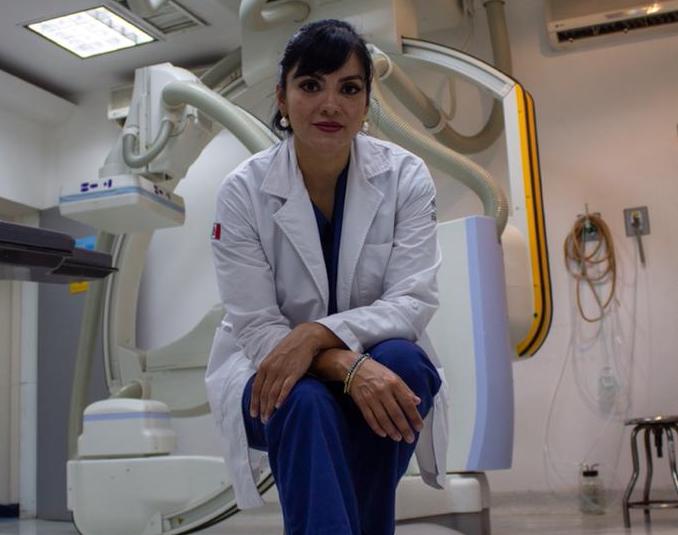In Mexico the majority of stroke victims arrive at hospital outside the therapy window. For one trailblazing interventional neuroradiologist, intent on rescripting stroke treatment in her country, one solution lies in opening the window wider.

In Mexico City on the morning of 30 October 2021, a group of placard-waving walkers sets out from the Estela de Luz, the wafer-like monument commemorating Mexico’s independence from Spanish rule, in the direction of El Ángel, the victory column erected along the Paseo de la Reforma for the same purpose 100 years earlier. Many of the walkers have one foot, one arm and part of their face covered by bandanas – not in protest but in solidarity with stroke victims, these accoutrements simulating the sequelae of stroke.
Leading the walk is the organizer Dr Ramiro Lopez alongside Dr Dulce Bonifacio, one of a handful of interventional neuroradiologists in Mexico who are capable of removing a clot from a patient’s artery through endovascular thrombectomy. Being on the front line is second nature for Dr Bonifacio who is the founder and co-ordinator of ResISSSTE Cerebro, a network to facilitate treatment and transfer of stroke patients, and in addition runs a residency programme at her hospital to train more doctors in interventional neuroradiology.
It’s hard to believe that just over three years have passed since she arrived in Mexico City intent on rewriting the script for stroke treatment in Mexico.
Mexico City was where Dr Bonifacio received her training in interventional neuroradiology, an eight-year journey that began when, as a young mom at 25 with the ink not yet dry on her first degree in medicine, she decided that this was how she would impact her patients’ lives and give life a chance. After six frustrating years working at under-resourced hospitals in her hometown of Veracruz, she returned to the world’s 10th most populous city, joining the Centro Medico Nacional 20 de Noviembre, a public hospital whose name commemorates the start of the Mexican Revolution.
Dr Bonifacio arrived with plans for a revolution of her own.

A life-saving network
Centro Medico Nacional 20 de Noviembre is a hospital that serves primarily federal government employees – teachers, policemen and civil servants who receive health coverage and other social services from the Mexican State Employees’ Social Security and Social Services Institute that goes by the acronym ISSSTE, and of which Dr Lopez is the medical director. Between 2015 and 2020 this Institute registered the discharge of 22,000 patients due to cerebral vascular events, a number that reflects the burden of stroke in a Mexico where it is a leading cause of death and disability, impacting 18.2 per 1000 people over 60.
But in the year preceding Dr Bonifacio’s arrival, Centro Medico Nacional 20 de Noviembre had treated only two patients with thrombolysis.
Dr Bonifacio added the letters R-e-s before ISSSTE and the Spanish word for brain after, and with the support of the Angels Initiative began to recruit hospitals for a network that would be served with expertise on stroke treatment and organization, implement strategies to reduce treatment and transfer delays, and connect hospitals to 20 de Noviembre where the use of RAPID software to identify salvageable brain tissue optimised treatment decisions for patients who arrive more than six hours after symptom onset.
Within the first two years, hospitals in the ResISSSTE Cerebro network attended to 200 stroke patients, and in 2021 that number soared to 170, of which at least one patient has an extraordinary story to tell.

The seventh patient’s story
That this patient is able to tell his story at all is testimony to Dr Bonifacio’s trailblazing success in performing extended window thrombolysis and thrombectomies.
Of the 170 patients attended to in the ResISSSTE programme between March and October 2021, 100 were referred to Centro Medico Nacional 20 de Noviembre; 89 were diagnosed with acute stroke and 28 were treated with thrombolysis, delivering a thrombolysis rate of 21%.
Forty-nine patients underwent CT perfusion. Of these, nine were found to have suffered large vessel occlusion and were considered for thrombectomy. Seven had arrived in the extended window; following thrombectomy, six of the late arrivals had a modified Rankin Scale score of 2, indicating that they were largely able to resume their prestroke lives with only slight disability. The seventh patient was a different matter.
The 36-year-old male’s stroke symptoms had started at 2.20pm the previous day. He reached a hospital outside the ResISSSTE programme by 5.30pm and was transferred to a network hospital at 10am the following morning. By the time he arrived at 20 de Noviembre, 23 hours had elapsed from symptom onset. His NIHSS score was 11.
Advanced imaging confirmed the patient was a candidate for thrombectomy, following which his NIHSS score dropped to 4, indicating a strong possibility for a good recovery.
Courage and resistance
The network is growing and working but it is slow, Dr Bonifacio says. The ambulance service is under pressure, public awareness remains low and as few as 17% of stroke patients arrive within 3 hours of symptom onset. The programme needs government support to replicate the network in other parts of the country, and new networks need more specialists in interventional neuroradiology. To this end Dr Bonifacio has established a residency programme at her hospital, from which three
newly minted interventional neuroradiologists will graduate in 2022. The residents also assist with the database where all the patients in the network are registered. The goal is to publish the results.
The work is as frustrating as it is rewarding, Dr Bonifacio says, but when she encounters obstacles that seem insurmountable, the word ResISSSTE and its allusion to “resistencia” (Spanish for “resistance”) bolster her resolve.
“It’s a good name for this organisation,” she says. After all, every revolution begins with resistance.


